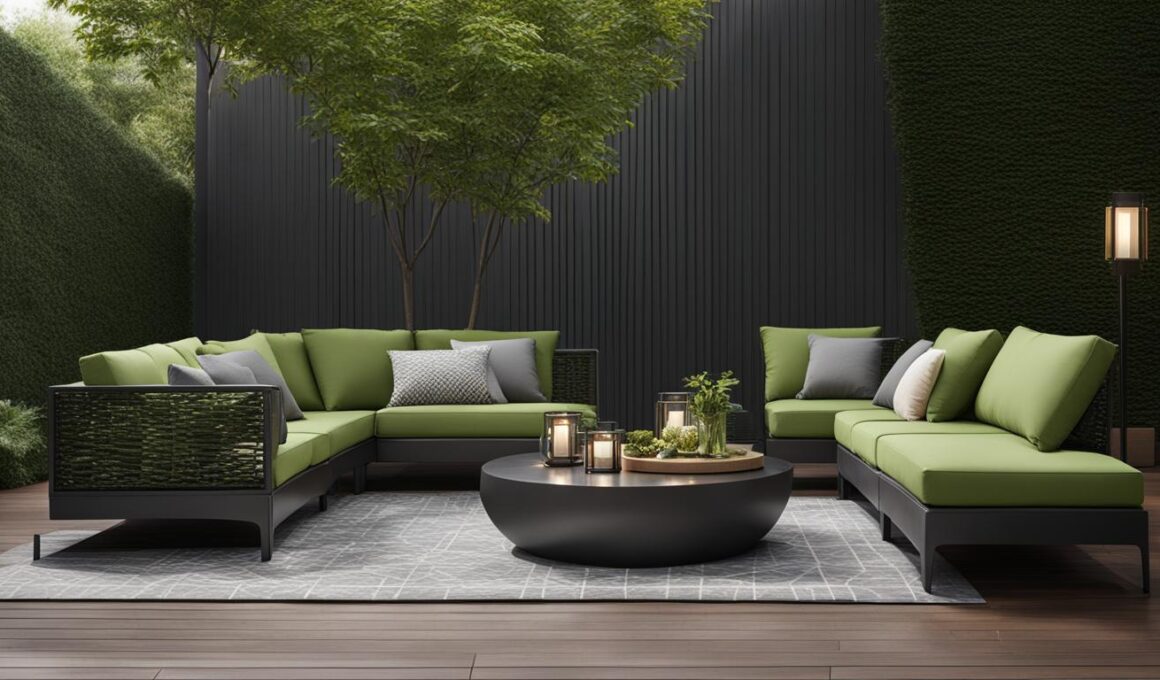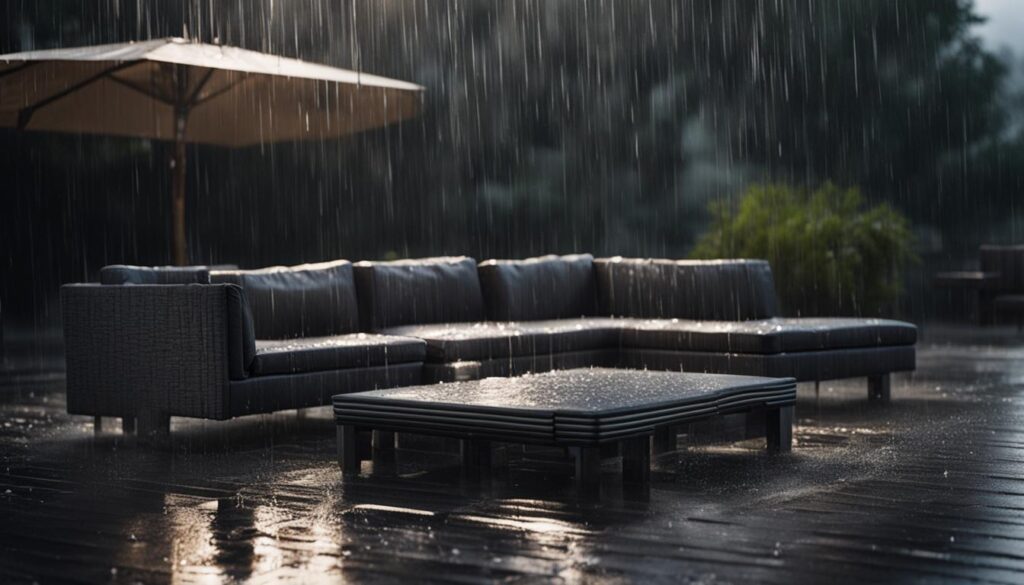When it comes to outdoor furniture, one common question that arises is whether it can be left out in the rain. The effects of weather can take a toll on furniture, especially if it is not adequately protected. Understanding how to protect your outdoor furniture from the rain is essential to ensure its longevity and maintain its aesthetic appeal.
Post Summary:- Outdoor furniture is designed to withstand the elements, but not all types are equally suited to rain.
- Weather-resistant furniture can resist some rain effects, while weatherproof furniture has a complete barrier against the elements.
- Materials like plastic lumber, aluminum, and sling fabric are popular choices for rain-resistant furniture.
- Wood types including teak, eucalyptus, and cedar are also durable options.
- Regular cleaning and maintenance can help extend the lifespan of outdoor furniture.
Understanding the Qualities of Outdoor Furniture Materials
When shopping for outdoor furniture, it’s essential to understand the different materials used and their respective qualities. Each material has its own benefits and considerations, ranging from weather-proof capabilities to maintenance requirements, and even stylistic preferences.
Wood
Wooden patio sets, such as those made from teak, eucalyptus, and cedar, not only offer durability but also add a rustic and natural charm to outdoor spaces. These woods are known for their ability to withstand the elements, making them a popular choice for outdoor furniture.
Metal
Metal furniture, particularly aluminum and steel, is another common option for outdoor settings. These materials are strong, sturdy, and easy to maintain. They can withstand various weather conditions, including rain, without the risk of rust or degradation.
Plastic
Plastic furniture is lightweight, affordable, and available in a wide range of styles. It is resistant to moisture and weather damage, making it an excellent choice for those looking for low-maintenance outdoor furniture. However, it’s important to note that not all plastic furniture is created equal, so ensure you choose high-quality plastic pieces for optimal durability.
Wicker
Wicker furniture, typically made from natural materials like rattan or bamboo, exudes a charming and classic appeal. However, it may require extra protection from the rain. Natural wicker can be susceptible to moisture damage, so consider using covers or storing it in a sheltered area when not in use.
Outdoor Fabric
Outdoor fabric, such as Sunbrella, is specially designed to withstand outdoor conditions, including rain. It is made to be water-resistant and fade-resistant, ensuring that your patio cushions and upholstery stay in good condition even after exposure to moisture.
Concrete
Concrete furniture is known for its durability and weather resistance. It is heavy, making it less prone to being blown away by strong winds. Additionally, it can withstand rain without the risk of rot or damage.
Summary
Choosing the right outdoor furniture material involves considering factors such as weather-proof capabilities, maintenance requirements, and personal stylistic preferences. Whether you opt for wood, metal, plastic, wicker, outdoor fabric, or concrete, each material has its own unique qualities that contribute to the overall durability and aesthetic appeal of your patio sets.
Pros and Cons of Leaving Outdoor Furniture Out in the Rain
Leaving outdoor furniture out in the rain has its pros and cons. It can be convenient, as you don’t have to constantly move furniture in and out of storage. Additionally, rain naturally cleans the furniture, resulting in less maintenance for you. However, there are also potential drawbacks to consider.
One of the main cons is the risk of damage to the furniture. Continuous exposure to rain can lead to various issues such as mold, mildew, and rot. This can particularly affect furniture made from materials that are not fully weatherproofed. Additionally, rain can cause rust on metal furniture and fading on fabrics, thus reducing the overall lifespan of your outdoor furniture.
To determine whether leaving your furniture out in the rain is a good idea, it’s important to consider the quality and construction of the furniture. High-quality, weather-resistant materials are more likely to withstand the effects of rain without significant damage. On the other hand, lower-quality materials may require additional protection or the need to be stored indoors during wet weather.
In conclusion, while leaving outdoor furniture out in the rain can be convenient and require less maintenance, it also comes with the risk of damage and degradation. It’s important to carefully consider the material and construction of your furniture and take appropriate measures to protect it from rain, such as using covers or bringing it indoors during wet weather. Regular inspections and maintenance are also essential to ensure the durability and longevity of your outdoor furniture.
| Pros | Cons |
|---|---|
| Convenience | Potential for damage |
| Easy maintenance | Mold, mildew, and rot |
| Rust and fading |
Tips for Protecting Outdoor Furniture from the Rain
When it comes to protecting your outdoor furniture from the rain, there are several effective strategies you can employ. By taking the necessary precautions, you can ensure that your furniture remains in great condition for years to come. Here are some tips to help you keep your outdoor furniture safe and dry:
- Invest in rainproof covers: One of the best ways to protect your outdoor furniture from the rain is to use rainproof covers specifically designed for this purpose. These covers provide a barrier against moisture, preventing it from seeping into your furniture.
- Consider indoor storage: If you have the space, storing your outdoor furniture indoors during rainy periods can offer optimal protection. This will shield your furniture from not only the rain but also other elements such as wind and harsh sunlight.
- Choose sheltered placement: If bringing your furniture indoors is not feasible, consider placing it under a sheltered area such as a porch or awning. This will provide some protection from the rain, reducing the risk of damage.
- Apply sealants: For wooden furniture, applying a sealant can create an additional layer of protection against moisture. Be sure to choose a sealant suitable for outdoor use and follow the manufacturer’s instructions for application.
- Elevate your furniture: To prevent standing water damage, consider elevating your outdoor furniture off the ground. This can be done by using furniture risers or placing the furniture on a raised platform.
By following these tips, you can effectively protect your outdoor furniture from the rain and extend its lifespan. Remember to regularly inspect and clean your furniture to identify any signs of damage or wear and tear, ensuring prompt repairs if needed. With proper protection and maintenance, your outdoor furniture will continue to bring you joy for years to come.
Comparison of Outdoor Furniture Materials
| Material | Weather-Proof Capabilities | Maintenance Requirements |
|---|---|---|
| Teak | High resistance to rain and moisture | Regular cleaning and occasional refinishing |
| Plastic | Water-resistant | Easy to clean |
| Aluminum | Rust-resistant | Minimal maintenance |
| Wicker | May need extra protection from rain | Regular cleaning and occasional sealing |
| Concrete | Weather-resistant | Sealing may be necessary |
Choosing the right outdoor furniture and taking the necessary precautions can help ensure that your furniture remains in good condition, even when exposed to rain. By understanding the qualities of different materials, protecting furniture from moisture, and performing regular maintenance, you can enjoy your outdoor space without worrying about the effects of rain.
Expert Recommendations for Rainproof Outdoor Furniture
When it comes to protecting your outdoor furniture from rain, following expert recommendations can help ensure its longevity. We have gathered information from multiple sources to provide you with valuable insights and actionable tips for rainproofing your furniture.
Comparison of Rainproof Outdoor Furniture Options
Before we dive into the recommendations, let’s take a look at a comprehensive table comparing different rainproof outdoor furniture options based on their material, durability, and weather resistance. This table will help you make an informed decision when selecting the right furniture for your outdoor space:
| Material | Durability | Weather Resistance |
|---|---|---|
| Plastic Lumber | High | Excellent |
| Aluminum | High | Excellent |
| Sling Fabric | Moderate | Good |
| Teak | High | Excellent |
| Eucalyptus | Moderate | Good |
| Cedar | Moderate | Good |
Note: This table is for informational purposes only and should be used as a general guide. Individual furniture products may vary in durability and weather resistance.
Recommended Rainproofing Strategies
Based on expert advice, here are some key strategies to effectively protect your outdoor furniture from the rain:
- Invest in high-quality rainproof covers designed specifically for outdoor furniture. These covers should be UV-resistant, waterproof, and breathable to prevent mold and mildew formation.
- If possible, bring your furniture indoors or store it in a shed or garage during periods of heavy rain or when not in use. This provides the ultimate protection against moisture and other environmental elements.
- Consider the placement of your furniture. Position it in a sheltered area such as a porch, patio awning, or under a gazebo to minimize exposure to rain.
- Apply a sealant to wooden furniture to create a barrier against moisture. This helps prevent warping, cracking, and rotting caused by prolonged exposure to rain.
- Elevate your furniture off the ground using furniture pads or risers to prevent standing water from accumulating and causing damage.
By implementing these recommended strategies, you can significantly extend the lifespan of your outdoor furniture and enjoy its beauty and comfort for years to come.
Can Outdoor Furniture Help Protect Raised Garden Beds from Rabbits?
Outdoor furniture like fences, wire mesh, or garden netting can be effective in protecting raised garden beds from rabbits. These physical barriers act as a deterrent, preventing these pesky critters from accessing your precious plants and nibbling on them. By utilizing such protective measures, you can ensure that your garden beds remain safe and secure against rabbit invasions.
Conclusion
In conclusion, when it comes to outdoor furniture in the rain, it is crucial to prioritize protection, durability, and maintenance. Not all types of furniture can withstand the effects of rain, so it is important to choose weatherproof or weather-resistant materials like plastic lumber, aluminum, or certain types of wood. Regular cleaning and maintenance can help extend the lifespan of outdoor furniture.
While leaving furniture out in the rain may be convenient and require less maintenance, it can lead to damage and degradation over time. Factors like material quality and construction should be considered when deciding whether to leave furniture exposed to rain. Mold, mildew, rot, rust, fading, and wear and tear are common issues that can arise from continuous exposure to rain.
To protect outdoor furniture from the rain, there are several effective strategies. Using rainproof covers specifically designed for outdoor furniture can provide an extra layer of protection. Storing furniture indoors during wet periods, placing it under a shelter, applying sealants to wood furniture, or elevating furniture off the ground are all practical measures to prevent damage and extend its lifespan.
In summary, proper protection and maintenance are key to ensuring the durability of outdoor furniture in the rain. By taking the necessary steps to shield furniture from rain and addressing any damage promptly, you can enjoy your outdoor space for years to come.
FAQ
Can outdoor furniture be left out in the rain?
Yes, certain types of outdoor furniture can withstand rain, but it is important to consider the material and construction of the furniture. Some materials may require additional protection.
What are the qualities of outdoor furniture materials?
Wood, metal, plastic, wicker, outdoor fabric, and concrete are common materials used for outdoor furniture. Each material has its own advantages in terms of durability, maintenance, and style.
What are the pros and cons of leaving outdoor furniture out in the rain?
Leaving outdoor furniture out in the rain can be convenient and require less maintenance, but it can also lead to damage or degradation of the furniture over time.
How can I protect outdoor furniture from the rain?
You can use waterproof covers specifically made for outdoor furniture, store the furniture indoors during rainy periods, place it under a shelter, apply sealants to wood furniture, or elevate the furniture off the ground to prevent standing water damage.
What should I do if my outdoor furniture gets wet?
If your outdoor furniture gets wet, dry it off using a cloth or towel. If necessary, bring it inside, cover it, or place it under a shelter to protect it from further moisture. Promptly repair any damage that occurs.










